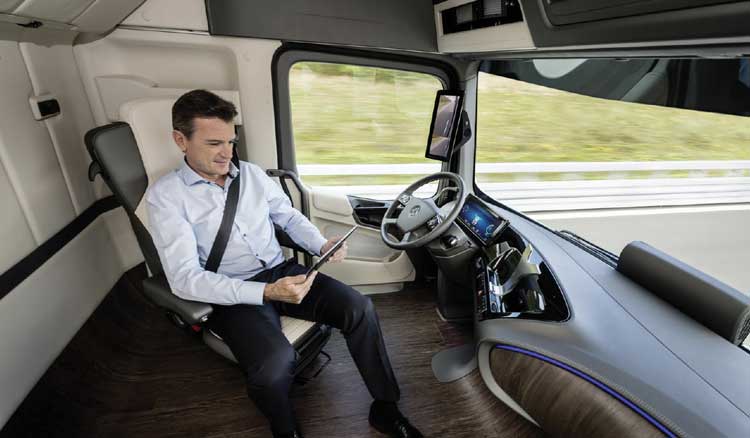Catching up with a colleague on some of the more interesting transport developments, he sent me a link to the Mercedes-Benz Future Truck 2025, a self-driving vehicle (SDV) revealed last year. The Future Truck has all the styling of a retro-future vehicle – with a wide faux wooden-panelled interior that looks remarkably spacious and, interestingly, a single swivel chair for the driver. The cab’s design is capable of reducing the fuel consumption by up to 5% and, more importantly, driving without driver input at some 90 km/h on the highways.
There’s a lot of tech in there to make it work – things like vehicle-to-vehicle communication for better positioning, cameras replacing side-mirrors and in-built navigation system – but I was struck by the photo of the driver, idly doing something on a tablet and looking utterly bored.
Reading further articles about the Future Truck, I read a number of cracks about finishing up ‘Game of Thrones’ novels or playing ‘Bejewelled’ while on the job, but while amusing, they fundamentally underestimate the driver’s worth. A human’s intrinsic value, regardless of their position, is their ability for creative thinking. Tedious and repetitive tasks thwart this.
No doubt SDVs are many a fleet manager’s dream come to life, a way to remove the hassle of driver management from the process altogether and simply focus on the hard numbers of fuel consumption and distance travelled.
There’s also been a focus on cutting jobs from the equation – in fact, a recent study by the Oxford Martin Programme on Technology and Employment suggests that almost 47% of American jobs could be replaced by technology in the next 20 years.
I prefer to think that SDVs have the opportunity to uplift drivers, especially when combined with the right tools.
Drivers under the current paradigm are a wasted resource; a person who essentially serves as the direct contact between your company and your clients in the last mile, but whose time is largely taken up shifting gears, pressing levers and spinning steering wheels.
Enterprise Digital Assistants (EDAs) and mobile devices are connecting drivers more intimately with your organisation’s scheduling and planning process – revised schedules can be pushed through automatically, paperwork is minimised and it helps improve the consistency of data between the various divisions of your transport operations.
What they can’t do, however, is give your driver more time. Certainly, they can and do improve efficiency and reduce the time it takes to capture, for example, on-site documentation at the client. But what if they could help your drivers utilise the 3-4 hours they spend in the cab daily for other purposes? What if that cab could be converted into an office?
With greater client integration, for example, you could have your drivers filling out necessary documentation prior to arriving at the client. Drivers could analyse loading capabilities and write up crucial suggestions for speedier delivery. What if your driver was also a sales rep, attempting to drum up new business while on the road, identifying new locations for expansion?
Mobile devices that integrate more strongly with your transportation activities eliminate the arbitrary boundaries logistics created to function in a traditional workplace environment, sectioning out activities where it’s always been a continuous, seamless process.
The Future Truck is a long way from real-world application – many traffic regulations would have to be updated to allow it on the roads, massive infrastructure would be required to support the truck’s technology, and it’s unlikely it’d be feasible for at least another 10 years. But there are transportation tools that are available right now that can more tightly incorporate your drivers into your transport processes, giving you real-time control over your schedule, a direct view into your staff members’ actions and giving your customer accurate and valuable feedback about the status of their orders and service requests.
Like the black and white illustration that could be an old crone or a young woman, the photo of the driver on his tablet is either a candidate for redundancy or an opportunity, and how you view it will determine your company’s success in the future.

.jpg)


